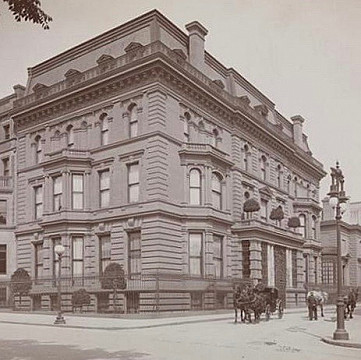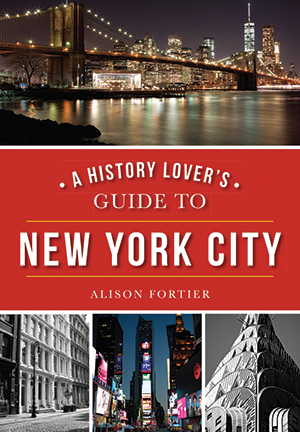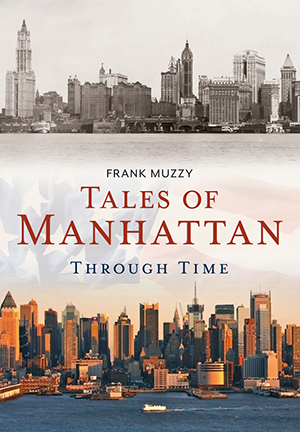Whitney Mansion
871 Fifth Avenue, Manhattan, New York
Completed in 1902, for the twice widowed William Collins Whitney (1841-1904) though intended as a wedding present for his second wife - and a statement to those who disapproved of her! The original house at 871 Fifth Avenue (the Stuart Mansion) had been built in 1883 but when Whitney acquired it in 1896 he employed Stanford White to completely transform it into a Beaux-Arts "Palace of Art". Including the basement and servants quarters, it covered 54,000-square feet of living space but while World War II raged across Europe there were no takers for a house of such opulence and it was demolished. Today, the site is occupied by 870 Fifth Avenue....

This house is best associated with...
William C. Whitney is best remembered as the lawyer who became the U.S. Secretary of the Navy under Grover Cleveland, but he was a man with fingers in many pies and through facilitating contracts and loans to himself and his cronies he accumulated a substantial fortune. His brother, Henry, was President of the Metropolitan Steamship Company and Dominion Iron & Steel, and was therefore well-placed when William decided the U.S. Navy needed a new, modern fleet! Whitney also took over the State Trust Company which he used to give illegal loans to a small group of powerful friends who included P.A.B. Widnener, Anthony N. Brady, Thomas Fortune Ryan etc. Within just 5-years, Whitney had earned himself over $40 million and as the public were entirely oblivious to these dealings his name was considered in running for U.S. President!
Breaking through Payne
Whitney's first wife, Flora Payne, succumbed to illness in 1893 just four weeks after seeing their daughter, Pauline, introduced into society. Sad to say, Mr Whitney was most probably not as distressed as he might ought to have been. Three years previously in Washington D.C., he had started an affair with the beautiful young widow, Mrs Edith Randolph, the on-off mistress of J.P. Morgan. Whitney owed almost all of his success to his friend - Flora's brother - Colonel Oliver Payne. So, when this news reached the old Colonel, Whitney not only received a stiff reprimand, but a stark warning to stay away.
Whitney dutifully retracted, and for the next two years played the part of the grieving widower. But, after the socially accepted period of mourning was over, Whitney took his yacht up to Bar Harbor where J.P. Morgan was summering on his yacht with his wife, and - you guessed it - his mistress, Edith! It wasn't long before the silver-tongued lawyer had engineered himself an invitation to join them for the summer aboard the Morgan's yacht, Corsair. Mrs Morgan watched with sardonic pleasure as he worked his charm on Edith, prizing her from the jaws of the King of Wall Street under his very - sizeable - nose!
Whitney headed back to New York with a spring in his step and the following year (1896), he and Edith were married. When news reached Oliver Payne, he flew into a rage and swore to destroy his former friend. His first move was to dangle his millions in front of the Whitney children, promising more to those who took his side: Whitney's eldest son dropped "William" from his name and now referred to himself as "Payne Whitney," which won him $63 million from his uncle, and he still got $2.5 million when his father died!
Resistance to Payne
In 1869, it had been Oliver Payne who bought Whitney a mansion as a wedding present. In 1896, impervious to his family and society's remonstrations, Whitney was able to buy his own for his second wife, and it was to be a statement. That year, the Whitneys bought the Stuart Mansion at 871 Fifth Avenue. They liked its size and location, but although it was then only 13-years old, they found it to be already outdated. Hiring McKim, Mead & White - who also built their country home, The Manse, during the same period - the not-so-old mansion underwent a metamorphic transformation that would take six years.
Inevitable Payne
The seemingly blessed life that Whitney led came crashing down after just two years of wedded bliss. In 1898, while riding to hounds at their estate in South Carolina, Edith struck her head off a stone bridge. The fall paralyzed her from the neck down and the following year she was dead. Whitney saw the completion of their statement mansion, but 5-years later he died within its walls after the ill-effects of having his appendix removed... and rumors rippled through society that Oliver Payne had taken his revenge!
Breaking through Payne
Whitney's first wife, Flora Payne, succumbed to illness in 1893 just four weeks after seeing their daughter, Pauline, introduced into society. Sad to say, Mr Whitney was most probably not as distressed as he might ought to have been. Three years previously in Washington D.C., he had started an affair with the beautiful young widow, Mrs Edith Randolph, the on-off mistress of J.P. Morgan. Whitney owed almost all of his success to his friend - Flora's brother - Colonel Oliver Payne. So, when this news reached the old Colonel, Whitney not only received a stiff reprimand, but a stark warning to stay away.
Whitney dutifully retracted, and for the next two years played the part of the grieving widower. But, after the socially accepted period of mourning was over, Whitney took his yacht up to Bar Harbor where J.P. Morgan was summering on his yacht with his wife, and - you guessed it - his mistress, Edith! It wasn't long before the silver-tongued lawyer had engineered himself an invitation to join them for the summer aboard the Morgan's yacht, Corsair. Mrs Morgan watched with sardonic pleasure as he worked his charm on Edith, prizing her from the jaws of the King of Wall Street under his very - sizeable - nose!
Whitney headed back to New York with a spring in his step and the following year (1896), he and Edith were married. When news reached Oliver Payne, he flew into a rage and swore to destroy his former friend. His first move was to dangle his millions in front of the Whitney children, promising more to those who took his side: Whitney's eldest son dropped "William" from his name and now referred to himself as "Payne Whitney," which won him $63 million from his uncle, and he still got $2.5 million when his father died!
Resistance to Payne
In 1869, it had been Oliver Payne who bought Whitney a mansion as a wedding present. In 1896, impervious to his family and society's remonstrations, Whitney was able to buy his own for his second wife, and it was to be a statement. That year, the Whitneys bought the Stuart Mansion at 871 Fifth Avenue. They liked its size and location, but although it was then only 13-years old, they found it to be already outdated. Hiring McKim, Mead & White - who also built their country home, The Manse, during the same period - the not-so-old mansion underwent a metamorphic transformation that would take six years.
Inevitable Payne
The seemingly blessed life that Whitney led came crashing down after just two years of wedded bliss. In 1898, while riding to hounds at their estate in South Carolina, Edith struck her head off a stone bridge. The fall paralyzed her from the neck down and the following year she was dead. Whitney saw the completion of their statement mansion, but 5-years later he died within its walls after the ill-effects of having his appendix removed... and rumors rippled through society that Oliver Payne had taken his revenge!
The "Palace of Art"
The cost of the renovations amounted to a staggering $3.5 million. In contrast to other mansions, Whitney's ballroom was just that, a ballroom. It did not double as an art gallery or another reception room when not in use. In order to incorporate the 63-foot long by 45-foot high ballroom, an entire new wing was added on to the mansion. It was originally constructed for the chateau near Tours of César Phoebus d'Albret (1614-1676) before being moved to Paris in the early 19th century. After that of Mrs Astor's at 840 Fifth Avenue, Whitney's French ballroom was then reputed to be the largest in New York City.
Though not quite finished, by way of a house-warming and to celebrate the coming-of-age of Whitney's eldest niece, Helen Tracy Barney (1882-1922), Whitney held a triumphant dinner-dance for 700-guests in January, 1901. Guests entered via the new entrance on 68th Street through the wrought iron and bronze gates from the Doria Palace in Italy.
The mansion was completed in 1902 after Whitney won an appeal over a court decision allowing him to retrofit three "exquisitely painted" 17th century ceilings (one in the main hall) that had been removed from the Barberini Palace in Rome: Berlin's Museum of Art had first attempted to buy them, but Whitney's pockets had proved deeper.
The reception hall featured 16th century stained glass windows and walls draped in antique tapestries, including the "The Drowning of Britomartis" that hung at the foot of the marble stairs - today scene at the Metropolitan Museum of Art. These 16th century Brussels tapestries were so desirable that they were borrowed for the Coronation of the British King Edward VII in 1901. Aside from Whitney's library replete with his own collection of books from Paris, there was art, murals, Persian rugs and collected antique treasures throughout the mansion. The walls and ceilings were adorned with panelling from European palaces, marbles from Italy and medieval carvings from various cathedrals, all of which Stanford White masterfully succeeded in bringing together.
At the end of 1903, Whitney held another ball for his next niece's coming-of-age and entrée into society, Katherine Lansing Barney (1885-1958). A contemporary account reported that, "the walls and ceiling of the wide lower hall were trellised with vines in which were myriads of electric bulbs... red velvet carpets were thrown on the marble floor, and the stairways were filled in with plants and made into a big picturesque cosy corner.”
The "Silent" Smiths (1904-1910)
Three months later, Whitney was dead. He left an estate valued at $21 million, but despite having spent $3.5 million refurbishing his Fifth Avenue mansion, it was valued at just $1.4 million. That same year, the mansion and all its contents were swiftly bought up by James Henry "Silent" Smith (1855-1907) for a reported $2 million. Smith was a millionaire stockbroker whose fortune (reputed to be twice that of Whitney's) was for the most part inherited from his uncle, the banker George "Chicago" Smith (1808-1899)... of London!
Two-and-a-half years later, "Silent" Smith - whose entertainments at No. 871 had been anything but silent - was dead, while on honeymoon in Japan. The widowed Mrs Smith returned to New York and took up residence at her husband's townhouse. In the meantime, her only son by her first marriage, William Rhinelander Stewart, Jr. (1888-1945), agreed with Whitney's eldest son, Harry Payne Whitney (1872-1930), that should his mother ever decide to sell, he would give Harry first refusal on the house.
In 1910, a sales catalogue for the mansions and its, "decorations (that) are structurally an integral part to the mansion" was put together by Mr Thomas E. Kirby of the American Art Association. However, rather than hitting the open market, it appears that William Stewart was good to his word, selling the mansion and all its contents to Harry Payne Whitney (1872-1930) for $2.5 million. It had barely changed since his father had owned it.
Harry & Gertrude (Vanderbilt) Whitney (1910-1942)
Harry and his wife, Gertrude Vanderbilt (1875-1942), maintained the mansion as their townhouse for the next twenty years. After Harry died in 1930, Gertrude - a talented and well-known sculptress in her own right - spent increasingly more time down at The Manse, their estate in Long Island where she kept her studio. By 1942, the world was at war, the Gilded Age was over and Fifth Avenue was no longer what it had been. Gertrude put the house and its contents up for sale just days before she died.
The auction - which in many ways represented the close of the Gilded Age era - was a well-publicised event that saw the contents of the house once again dispersed far and wide. The house itself was demolished and the apartment block at 870 Fifth Avenue now occupies the site where the "Palace of Art" once stood.
The auction - which in many ways represented the close of the Gilded Age era - was a well-publicised event that saw the contents of the house once again dispersed far and wide. The house itself was demolished and the apartment block at 870 Fifth Avenue now occupies the site where the "Palace of Art" once stood.
You May Also Like...
Categories
Styles
Share
Stanford White: Decorator in Opulence and Dealer in Antiquities (2005), by Wayne Craven; Silent Smith Dies in Japan, Los Angeles Herald; William C. Whitney Mansion, Gilded Age Era Blog; The Lost William Whitney Mansion, DaytoninManhattan Blog; The Whitney Residence, mrmhadams blog; William Whitney swaps a Mistress with J.P. Morgan, New England Historical Society; The Perils of Pauline Payne Whitney, SchoolfieldCountryHouse
Connections
There are 2 members connected to this house, are you? Connect to record your link to this house. or just to show you love it! Connect to Whitney Mansion →
Samantha Meredith-Horne loves Whitney Mansion
<private> loves Whitney Mansion


















